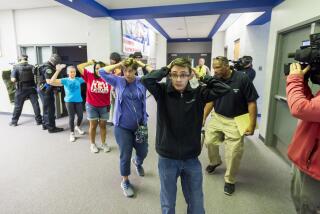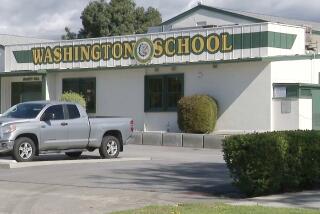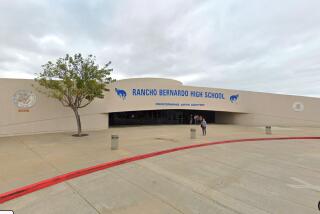Colorado school faces accusation that it could have prevented shooting
CENTENNIAL, Colo. — Sometimes a kid is just mouthing off. Sometimes he could become the next school shooter. How do teachers and principals know the difference?
The short but disquieting answer: They might not.
In post-Columbine America, where school shootings seem to come with frightening frequency, safety experts say no report of trouble should be ignored — threats against faculty or fellow students, erratic behavior, unusual fascination with weaponry.
“We need common sense, but what has to be consistent is that every report has to be treated seriously,” said Kenneth Trump, president of National School Safety and Security Services, a consulting firm that works with districts to increase preparedness. “We tend to find ways to talk ourselves out of believing a threat is real, that it could ever happen in our school. And nine out of 10 times the threat may turn out to be unfounded, but nobody wants to be number 10.”
Last month, on a sunny Friday in the Denver suburbs, Arapahoe High School became a No. 10.
Karl Pierson, a bright, athletic 18-year-old senior with a history of threatening outbursts, stormed into the school Dec. 13, armed with a shotgun and Molotov cocktails. Pierson shot and killed classmate Claire Davis, apparently at random, unsuccessfully searched for his debate coach, then turned the gun on himself.
Now, the grieving school faces disturbing allegations that administrators ignored warning signs.
“Claire Davis and Karl Pierson did not have to die. Policies and procedures that were put in place to protect the students and faculty were not followed,” said Cameron Rust, an unarmed school security guard on duty that day who is on administrative leave. He outlined his concerns in two Jan. 16 Facebook posts that first appeared on the page of his aunt, Bonnie Rust.
Cameron Rust contends that the school knew Pierson made a death threat against the debate coach and school librarian, Tracy Murphy, three months before the shooting. He alleges that the administration ignored a security team report that Pierson was looking up guns on his computer in the cafeteria, and that the day before the shooting Pierson was sent home after an angry outburst directed at another teacher.
Students who knew Pierson were concerned too. Larson Ross, a debate team captain, told The Times last month that his friends had talked an hour before the shooting about reporting Pierson because they feared he was “going off the edge.”
“Karl Pierson was a known threat for a long time; he should have gotten the necessary help and appropriate resources should have been involved,” Rust wrote. “If the proper investigation took place, Karl would have been unable to purchase a gun and ammunition more than a week prior to the shooting. Had he gotten the necessary help, I doubt his feelings of anger would have consumed him.”
Rust, who was a coach on the football and softball teams, has received support from students. Jordan Macomber, 16, started a Facebook page, “Bring Back Cameron Rust,” that has more than 1,200 members. All three security guards were put on routine administrative leave after the shooting, but Rust is the only one still on leave, his attorney says. Rust says he is being punished for speaking out.
The school and the district declined to comment, referring all questions to the Arapahoe County Sheriff’s Office. But Littleton Public Schools Supt. Scott Murphy sent an open letter to parents last week, warning that some of what they were reading in the media “is based on inaccurate information, rumor and innuendo.” He urged patience during the investigation.
Arapahoe County Sheriff Grayson Robinson said Rust had been interviewed by investigators and would be interviewed again. In an email, Robinson said his office would have no further comment on Rust.
Schools across the nation are watching and wondering whether Arapahoe will become a cautionary tale.
“It’s always a balancing act for principals and administrators,” said Bill Bond, a specialist in school safety for the National Assn. of Secondary School Principals.
He speaks from personal experience. Bond was principal at Heath High School in West Paducah, Ky., on Dec. 1, 1997, when a 14-year-old boy opened fire on a prayer group, killing three students and injuring five others. In retrospect, he said, there were warning signs.
“Predicting is one of those things that is racked with peril,” Bond said. “It is nearly impossible to profile a potential school shooter.”
Schools must not turn into police states, where every odd behavior or angry outburst equates with impending mass murder, he said. “Every single day in an American high school, some kid is having a bad day. Kids are going to say stupid stuff.”
The trick is cracking what is behind the words, he said. He believes all students deserve to have at least one adult who truly knows them and their personality. That could be a teacher or principal, but also a bus driver, counselor, coach or cafeteria worker. “You can’t really investigate the words unless you know the kid and the context,” he said.
“If it goes beyond just running his mouth, that’s when you need to step up your action,” Bond said. Staff and fellow students should look for patterns of behavior or sudden dark changes in attitudes and not be afraid to speak up. Any accompanying talk of hit lists or revenge should be quickly addressed, including involving parents. Calling the police might be necessary.
Trump agrees. “It doesn’t have to be punitive,” he said. “The goal is to prevent a tragedy and to get help for the child.”
Trump favors threat assessment teams that include counselors, school psychologists, security guards and teachers. “Different people may have different slivers of information that, standing alone, would not shoot up a red flag. But put together they trigger a three-alarm fire,” he said.
Rust, the security guard, hired a Denver civil rights and employment attorney this month.
“I am protecting his right to speak under the 1st Amendment and to protect his employment,” attorney Paula Greisen said. “He cares about the students and wants to keep them safe. That is his only motive.”
More to Read
Start your day right
Sign up for Essential California for news, features and recommendations from the L.A. Times and beyond in your inbox six days a week.
You may occasionally receive promotional content from the Los Angeles Times.






